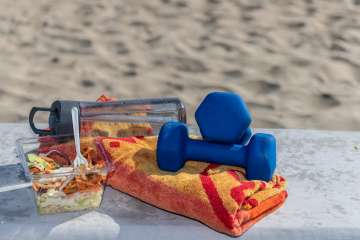Exercise Guidelines
Find your care
You receive customized, exceptional diabetes treatment and education in a caring environment. Call 310-825-7922 to connect with a diabetes specialist.
Type 1 Diabetes exercise guidelines
Benefits of exercise

- Sharpens the mind and tones the body
- Helps control stress and improves mood and overall well-being
- Aids in weight management and weight loss
- Improves blood pressure and cholesterol levels
- Increases insulin sensitivity and lowers blood glucose
Factors that may affect your blood glucose during exercise
- How fit you are – Less fit? Blood glucose can drop quickly.
- Type of exercise – Anaerobic exercise may raise blood glucose. Aerobic is more likely to have an immediate effect on lowering blood glucose.
- Insulin on board (IOB) – The more insulin on board the more likely you are to go low. Not enough insulin on board may result in high blood glucose.
- When and what foods were last eaten
- Temperature and humidity – Hot? Blood vessels can dilate and blood glucose may drop.
- Hydration status – Dehydrated? Your blood glucose may rise.
- Current blood glucose
- Time of day – Insulin sensitivity changes during the day: Less sensitive early in the day — you may need to “break the fast,” but take less insulin with food; more sensitive in the afternoon and evening, which may increase your risk of hypoglycemia.
*Everyone’s response to physical activity is different. Review each of these factors with your diabetes team to positively impact glucose control with exercise.
Glucose metabolism and exercise

In individuals without diabetes
- Insulin output by the pancreas decreases to compensate for decreased needs in the body.
- Exercise activates non-insulin dependent glucose transport into muscle cells.
- As insulin levels decrease, counter-regulatory hormones cause the liver to release glucose to keep blood glucose stable.
In individuals with diabetes
- Insulin output by the pancreas does not change as the majority, if not all, of insulin is injected.
- Circulating insulin levels do not decrease but muscles take in more glucose and any insulin present becomes more efficient in its ability to lower glucose.
- High insulin levels impair glucose release from the liver low glucose levels.
- Peak performance occurs when insulin levels and fuel available for energy are balanced, keeping blood glucose in a normal range.
Exercise tips

- Check your blood glucose 15-30 minutes before exercise, and every 30 minutes to 1 hour during exercise.
- Check your insulin-on-board (IOB) before starting exercise. It may help to decide whether you need a snack to prevent hypoglycemia. The more insulin you have on board, the higher the likelihood of a low glucose. You may require more carbohydrates prior to exercise.
- If your blood glucose is higher than 250 mg/dl, exercise may be detrimental. Review exercise glucose targets with your endocrinologist or diabetes team.
- If your blood glucose is less than 100 mg/dl, consider eating a snack without insulin or oral medication before you exercise. Monitor your blood glucose every 30 minutes to 1 hour during activity.
- Exercise with a friend or in a group if you are new to exercising.
- Keep your meter accessible. Glucose monitoring with a continuous glucose monitoring (CGM) device helps to assess trends and can guide decision-making.
- Carry fast-acting carbohydrates with you to treat unexpected low blood sugar.
- Drink plenty of water to prevent dehydration. Have fluids available during activity. Consider having an energy drink with you for a carbohydrate replacement while exercising.
- Consider adjusting your oral medication or insulin prior to exercise. You may need to decrease your mealtime dose/bolus or use a temporary basal rate (via insulin pump) while exercising.
- Consult your diabetes team to provide specific recommendations for treatment surrounding exercise and diabetes.
Preventing hypoglycemia during exercise
Consult your diabetes team for specific recommendations for treatment surrounding exercise and diabetes. The following are steps that may reduce the risk of hypoglycemia during exercise:
- Set a temporary basal rate to reduce insulin delivery before, during and after exercise. Set your temporary basal rate approximately one hour prior to exercise to reduce the amount of insulin-on-board (IOB).
- Eat a snack with carbohydrates (and protein) one hour prior to exercise if needed. Consider omitting or reducing the oral medication dose/insulin bolus.
- If on an insulin pump, check your insulin-on-board (IOB). If taking multiple daily insulin injections (MDI), start using a phone app that can help determine how much insulin you have on board. If you have active insulin remaining from a previous bolus, consider eating a larger snack.
- In some circumstances, it is recommended to eat 15-30 grams of carbohydrate for every 30 minutes to 1 hour of exercise. Energy drinks, energy gels and shot blocks are all good options.
- If you are using a closed loop insulin pump, consider using the exercise mode
Blood Glucose Recommendations for Carbohydrate Intake
Before exercise:
- BG less than 80 mg/dl: Eat a minimum of 30 grams of carbohydrates and wait 15 minutes prior to exercising.
- BG 80-180 mg/dl: Eat 15-30 grams of carbohydrate
- BG greater than 180 mg/dl: You may not need a snack
Remember that complex carbohydrate turns to glucose in 1-2 hours, protein in 3-4 hours and fat extends the effect. Consume one hour prior to exercise for 30 minutes of exercise. For more than 30 minutes, increase snack to 30 grams of carb.
Examples of 15-30 g Carbohydrate Snacks:
- 1 small banana or apple with 1-2 T peanut butter
- 1 oz. nuts with 2 T dried fruit
- 4-5 peanut butter crackers or crackers with cheese
- ½ sandwich
- Trail mix — 1/2 cup cereal, 1 T dried fruit, ¼ cup nuts
- 1 granola bar (Luna, Nature Valley, Gnu, Lara, Kind )
- 1 cup light yogurt with nuts or 1 cup plain yogurt with dried fruit
Preventing post-exercise hypoglycemia
- Check blood glucose every 1-2 hours post-exercise.
- There are two peaks of increased glucose requirements after exercise:
- Approximately 60-90 minutes post-exercise, glycogen stores are being replenished and there is increased insulin sensitivity.
- Additionally, there may be a change in metabolic rate and reduction in insulin requirements for up to 24 hours.
Combatting the first wave of hypoglycemia
- Eat a carbohydrate snack or drink following exercise (trial 15-30 grams but this may need to be adjusted).
- Reduce your basal rate following exercise for 1-2 hours.
Combatting the second wave of hypoglycemia
- Reduce your basal dose:
- If using MDI, decrease long-acting insulin dose
- If using a pump, set a temporary basal rate to reduce overnight basal rates.
Review specific recommendations with your diabetes team prior to adjusting carbohydrate intake and insulin dosing.
*Effects of exercise can last as long as 24-48 hours. To recover glycogen stores eat a balance of complex carbohydrates, protein and fat.
Post-exercise hyperglycemia can occur if:
- Hypoglycemia occurred during exercise (rebound hyperglycemia).
- There were too many carbohydrates consumed before exercise.
- Insulin was decreased too much prior to exercise.
- There was a high level of counter-regulatory hormones released during exercise allowing increased glucose release by the liver.
When you exercise, muscles need energy and the liver increases the amount of glucose it releases into the blood. With diabetes, you are unable to secrete insulin to compensate for the increased counter-regulatory hormones and glucose release.
If insulin levels are low, even though there is an increase in efficiency, glucose is not transported into the cells. Additionally, the liver pumps glucose into the blood and blood glucose rises.
Ways to combat hyperglycemia

- If you know that your blood glucose tends to rise with exercise, try taking a small dose of insulin pre-exercise.
- Consider a small amount of insulin post-exercise or an increase in the basal rate for 30 minutes to 1 hour. Be careful and review with your diabetes team before trying it.
- Hyperglycemia is usually transient and numbers generally go down within a few hours.
- When making corrections, lower the correction dosing.
- Remember to hydrate before and during exercise to help prevent hyperglycemia due to dehydration.
- Try to exercise at the same time of day to better understand blood glucose trends and risks of high and low glucose.
Exercise and insulin adjustments
- Insulin ratios may vary over different time periods throughout the day by exercise. You may need less insulin than usual.
- With exercise, bolus insulin for meals may be reduced by as much as 50% or more, especially if the bolus is within a few hours prior to, or just after, activity or exercise.
Here is a starting guideline (consult your diabetes team prior to making any adjustments to your regimen):
Reduce Meal Dose – For Activity Within 2 hours After the MealDuration Low
IntensityModerate
IntensityHigh
Intensity60 min
Reduce meal dose by10-20% 20-40% 30-60% 90 min
Reduce meal dose by15-30% 30-55% 45-75% 120 min
Reduce meal dose by20-40% 40-70% 60-90%
- If using an insulin pump, consider decreasing your basal rate by 50% when exercising for more than one hour.
- Decrease basal rate one hour prior to exercise and throughout the exercise period.
- Check blood glucose often to make food or insulin adjustments as needed.
- Test blood glucose prior to exercise. If blood glucose is in target range, consider eating 15-30 grams of carbohydrate. If exercising for longer than one hour, you may need to have 15 grams of carbohydrates every 30 minutes during exercise.